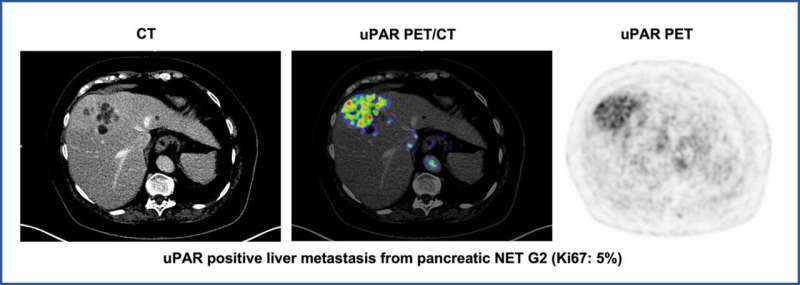New PET tracer shows promise for uPAR-targeted therapy of neuroendocrine neoplasms

A novel PET radiotracer can accurately assess the presence of a biomarker that indicates the level of tumor aggressiveness in neuroendocrine neoplasms (NENs). According to research published in the September issue of the Journal of Nuclear Medicine, the detection of the biomarker provides useful information for physicians to provide personalized care for patients with NENs and may also serve as a potential target for peptide radionuclide therapy (PRRT) for NEN patients.
NENs originate from the neuroendocrine cells and are found primarily in the gastrointestinal tract, pancreas, and lungs. The treatment for patients diagnosed with NENs ranges from indolent (causing little or no pain) to highly aggressive. Treatment is dependent upon the grade, or severity, of the disease, which makes accurate risk stratification important.
"Noninvasive tools to improve the risk stratification and guide decisions on treatment are warranted," said Andreas Kjaer, MD, Ph.D., DMSc, professor at Rigshospitalet and University of Copenhagen in Denmark. "In this study, we aimed to assess for the first time whether the urokinase plasminogen activator receptor (uPAR) radiotracer would show accumulation in NENs and if that accumulation would be associated with survival rates."
The prospective clinical phase II trial included 116 patients with NENs of all grades. Of these patients, 96 had whole body 68Ga-NOTA-AE105 uPAR PET/CT performed with evaluable lesions. Images were analyzed and the uPAR target-to-liver ratio was used to identify lesions as uPAR positive. Patients were then followed for at least one year to assess progression-free and overall survival. uPAR expression was seen in most patients with both low-grade and high-grade NENs. uPAR-positive lesions were noted in 68% of all patients and in 75% of patients with high-grade NENs. High uPAR expression was associated with a worse prognosis with regard to progression-free and overall survival.
"These findings are most encouraging as they imply that uPAR could be an attractive target for therapy both because of the availability of the target in patients with NENs and because of the possibility of specifically targeting lesions associated with poorer prognosis," Kjaer noted. "As many neuroendocrine tumors—particularly those of higher grades—are not eligible for the currently available somatostatin PRRT, uPAR PRRT could become a viable therapeutic option for these patients."
More information: Esben Andreas Carlsen et al, Prospective Phase II Trial of Prognostication by 68Ga-NOTA-AE105 uPAR PET in Patients with Neuroendocrine Neoplasms: Implications for uPAR-Targeted Therapy, Journal of Nuclear Medicine (2022). DOI: 10.2967/jnumed.121.263177



















